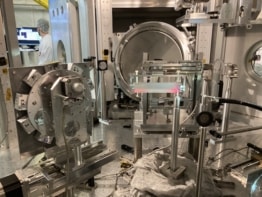
Years of research and development work have made compact, high-performance lasers ubiquitous for the near-infrared wavelengths used in telecommunications. However, lasers with an output in the visible range of the spectrum rely mainly on atomic or solid-state systems. Such systems often require bulky table-top lasers or a series of different semiconducting materials to function.
A team of researchers at NIST in the US has now addressed this problem by making a microchip-based laser that converts near-infrared laser light into any of a range of visible light colours – including red, orange, yellow and green – using a technique called third-order optical parametric oscillation (OPO). The device could allow for a host of applications in areas such as spectroscopy, precision timekeeping and quantum information science.
Nonlinear material converts incident light into two different frequencies
The principle behind the third-order OPO technique is to use a nonlinear material – in this case, silicon nitride (Si3N4) – to convert incident light in the near-infrared into two different frequencies. One of these output frequencies is higher than the frequency of the incident light, in the visible range, while the other is lower and lies deeper in the infrared.
In the nonlinear regime, light with a high enough intensity exits an optical material with a wavelength that does not necessarily match the wavelength of the light that has entered it. This is because bound electrons in the material re-radiate the light at frequencies that are different from those of the incident light. This situation is very different to an ordinary (linear) optical material, which radiates the same colour (think of light bouncing off a mirror or refracting through a lens).
Microresonators produce output light of different colours
In their work, researchers led by Kartik Srinivasan directed a beam of near-infrared laser light into a microresonator. This is a ring-shaped structure with a radius of 50 microns fabricated on a silicon chip. The light inside this device circulates roughly 5000 times before dissipating, building enough intensity as it does so to access the nonlinear regime – where it is converted to the two different output frequencies.

Optical ‘astrocomb’ could boost searches for Earth-like planets
The researchers fabricated several of these microresonators, each with slightly different dimensions on a chip. By carefully choosing these dimensions, they were able to ensure that different microresonators would produce different-coloured output light. This approach allowed a single near-infrared laser operating over a narrow range of wavelengths (from 780 nm to 790 nm) to generate visible-light colours ranging from green to red (560 nm to 760 nm), and infrared wavelengths ranging from 800 nm to 1200 nm. Any one of these wavelengths can be accessed simply by adjusting the dimensions of the resonators, Srinivasan explains.
While the work is currently still at the proof-of-principle stage, the researchers hope to combine their nonlinear optics technique with well-established near-infrared laser technology to create new types of on-chip light sources for a variety of applications. They report their work in Optica.


